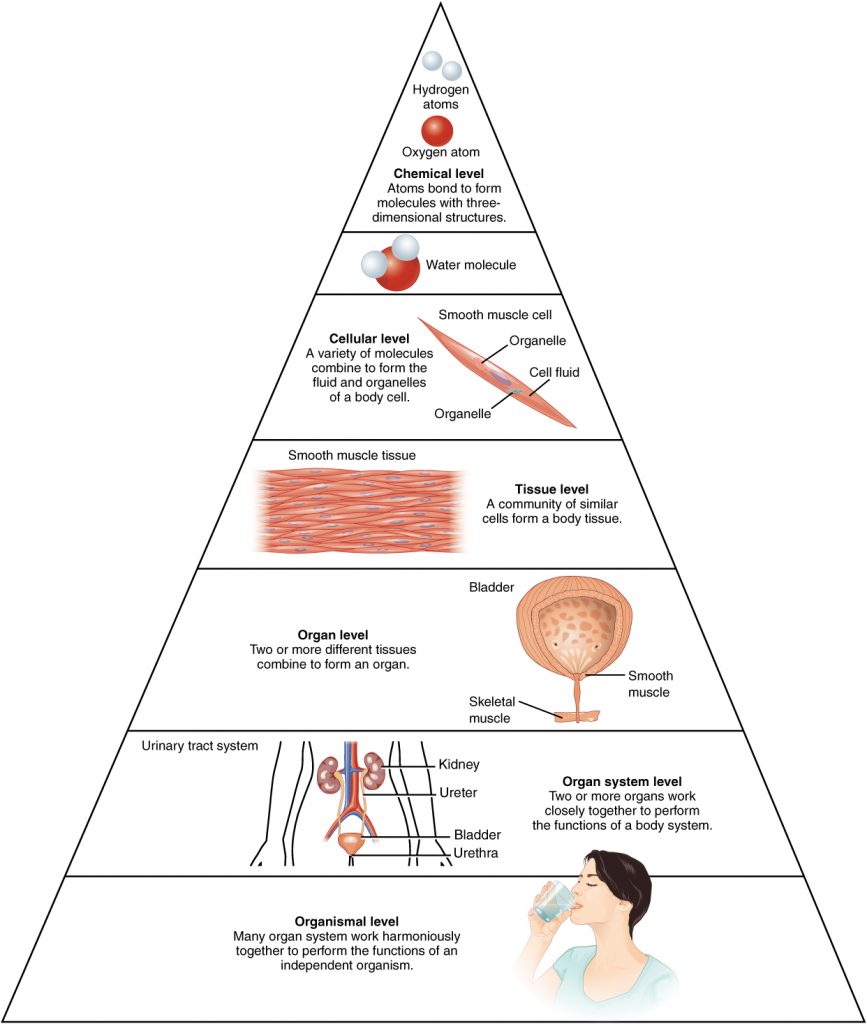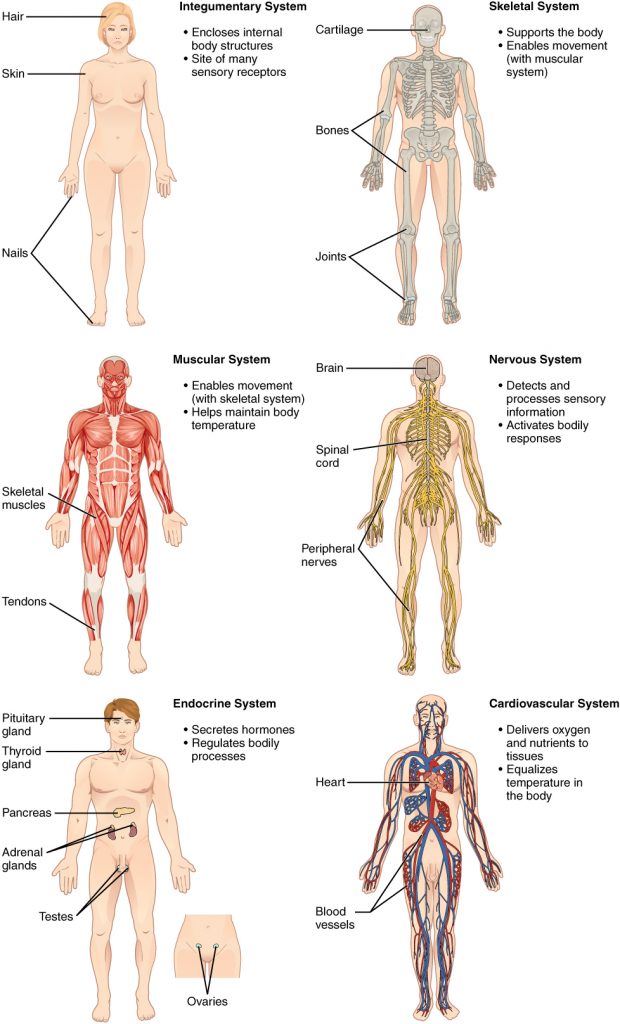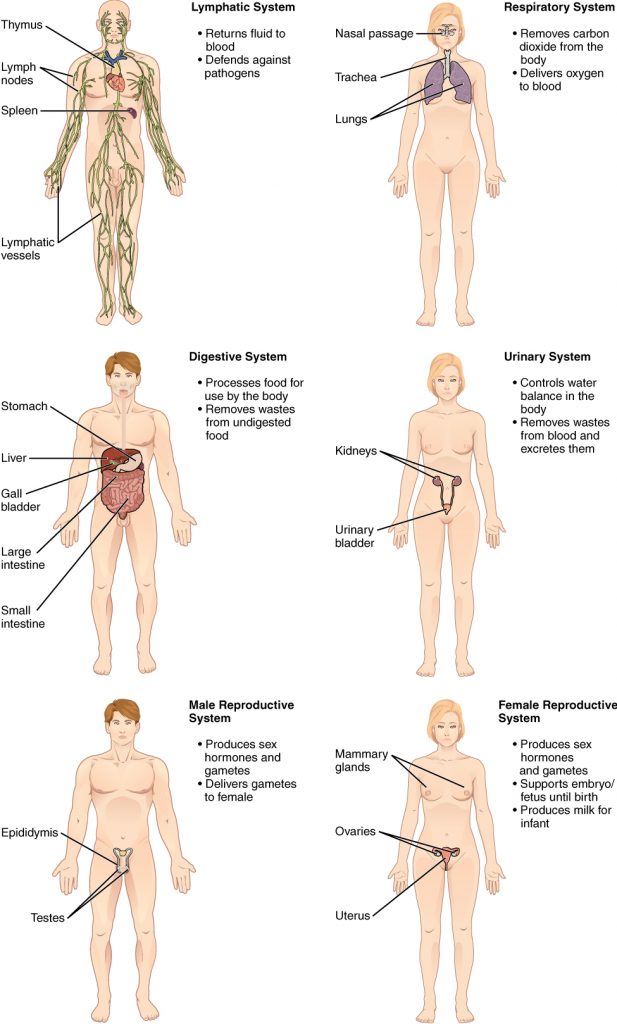6 Levels Of Body Organization
Theme 1: What Makes Us Unique?
1.1 Structural Organization of the Human Body
*
Earlier you begin to study the different structures and functions of the human torso, it is helpful to consider its basic architecture; that is, how its smallest parts are assembled into larger structures. It is convenient to consider the structures of the body in terms of fundamental levels of system that increase in complication: subatomic particles, atoms, molecules, organelles, cells, tissues, organs, organ systems, organisms and biosphere ( Effigy one ).
Levels of Structural Organization of the Human Torso

*
The Levels of Organization
To written report the chemic level of organization, scientists consider the simplest building blocks of matter: subatomic particles, atoms and molecules. All thing in the universe is composed of one or more than unique pure substances called elements, familiar examples of which are hydrogen, oxygen, carbon, nitrogen, calcium, and atomic number 26. The smallest unit of any of these pure substances (elements) is an atom. Atoms are fabricated upwardly of subatomic particles such as the proton, electron and neutron. Two or more atoms combine to form a molecule, such every bit the water molecules, proteins, and sugars constitute in living things. Molecules are the chemical building blocks of all torso structures.
Acell is the smallest independently functioning unit of measurement of a living organism. Even bacteria, which are extremely small, independently-living organisms, have a cellular construction. Each bacterium is a unmarried cell. All living structures of human anatomy contain cells, and most all functions of human physiology are performed in cells or are initiated by cells.
A man cell typically consists of flexible membranes that enclose cytoplasm, a water-based cellular fluid together with a variety of tiny functioning units called organelles. In humans, every bit in all organisms, cells perform all functions of life. A tissue is a grouping of many like cells (though sometimes composed of a few related types) that work together to perform a specific role. Anorgan is an anatomically distinct construction of the body composed of two or more tissue types. Each organ performs ane or more specific physiological functions. Anorgan system is a grouping of organs that piece of work together to perform major functions or meet physiological needs of the trunk.
Figure ii shows some of the organ systems of the body that nosotros will consider over the grade of this semester. Many organs have functions integral to more than i organ system.
Organ Systems of the Human Trunk


The organism level is the highest level of organization considered in anatomy/physiology. An organism is a living being that has a cellular structure and that tin can independently perform all physiologic functions necessary for life. In multicellular organisms, including humans, all cells, tissues, organs, and organ systems of the trunk work together to maintain the life and wellness of the organism.
*
Section Summary
Life processes of the human torso are maintained at several levels of structural organization. These include the chemical, cellular, tissue, organ, organ system, and the organism level. College levels of organisation are built from lower levels. Therefore, molecules combine to form cells, cells combine to course tissues, tissues combine to class organs, organs combine to form organ systems, and organ systems combine to form organisms.
*
Glossary
- jail cell
- smallest independently functioning unit of all organisms; in animals, a cell contains cytoplasm, composed of fluid and organelles
- organ
- functionally distinct structure composed of 2 or more than types of tissues
- organ organisation
- group of organs that work together to carry out a detail role
- organism
- living being that has a cellular structure and that can independently perform all physiologic functions necessary for life
- tissue
- group of similar or closely related cells that human activity together to perform a specific function
6 Levels Of Body Organization,
Source: https://open.lib.umn.edu/humanbiology/chapter/1-1-structural-organization-of-the-human-body/
Posted by: rossarishe.blogspot.com


0 Response to "6 Levels Of Body Organization"
Post a Comment